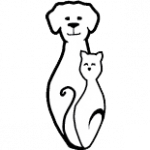Illustrated Articles
-
An E-collar or cone may be needed after your cat has surgery or if she has a wound. It can prevent your cat from licking their wound or scratching a wound on their head. Your cat should wear the E-collar following the directions provided by your veterinarian. You may need to make a few adjustments in your home to ensure your cat does not get stuck in confined spaces. It is not recommended to let your cat outdoors while she is wearing the collar. Also, you may need to adjust her feeding station to assist with eating. If your cat will not tolerate the E-collar, discuss other options with your veterinarian.
-
An E-collar or cone may be needed after your dog has surgery or if he has a wound. It can prevent your dog from licking their wound or scratching a wound on their head. Your dog should wear the E-collar following the directions provided by your veterinarian. You may need to make a few adjustments in your home to ensure your dog does not get stuck in confined spaces. Also, you may need to adjust his feeding station to assist with eating. It is not recommended to let your dog outdoors unsupervised while wearing the cone. If your dog will not tolerate the E-collar, discuss other options with your veterinarian.
-
Open and honest communication with your veterinarian and veterinary healthcare team throughout your cat's life lays the foundation for effective communication when that cat's life begins drawing to a close. Discussion with your veterinarian will clarify any specific medical implications of your cat's disease that can serve as benchmarks to suggest that euthanasia should be considered. Most often, euthanasia is provided at the veterinary practice or in your home. The veterinary healthcare team will be an important partner as you negotiate the difficult days and decisions leading up to your cat's peaceful passing.
-
Many pet owners decline to take their cats for regular veterinary care because they perceive that their cats resent and fear the visits. Fear, anxiety, and stress (FAS) are rooted in responses to stressful events, and result in both physiologic and behavioral changes. Fear Free® is an online certification course that provides veterinary professionals and other animal care providers with strategies and resources to alleviate or minimize FAS during veterinary visits.
-
Many pet owners decline to take their dogs for regular veterinary care because they perceive that their dogs resent and fear the visits. Fear, anxiety, and stress (FAS) are rooted in responses to stressful events, and result in both physiologic and behavioral changes. Fear Free® is an online certification course that provides veterinary professionals and other animal care providers with strategies and resources to alleviate or minimize FAS during veterinary visits.
-
To be classified as a fever of unknown origin (FUO), the body temperature must be above 103.5°F (39.7°C) for longer than a few days, with no obvious underlying cause based on history and physical examination. A fever is beneficial to the body, but if a fever remains above 106°F (41.1°C) for more than a few days several consequences occur within the body and can be life threatening. If your pet has a fever, your veterinarian will perform a thorough physical examination, perform diagnostic blood tests, urine culture, and possibly other diagnostic tests. Antibiotics are often prescribed. Cats that have persistent fever or a fever that waxes and wanes must undergo a thorough work-up so that the cause of fever can be discovered and treated before irreversible damage occurs.
-
There are a variety of frogs kept as pets. Most frogs should not be handled frequently, as their skin is delicate. This handout summarizes the variety of sizes and colors of various pet frogs, as well as cage and cleaning requirements.
-
Ferrets are naturally curious animals, and it is common for them to chew and swallow foreign material, which cdan cause gastrointestinal (GI) upset or obstruction. Typical swallowed objects include rubber bands, bits of rubber toy, foam, remote control buttons and other similar items. Hairballs are another potential cause of GI obstruction. Hairballs (trichobezoars) are compacted wads of fur, which may develop over time as a ferret grooms adn swallows fur. Unlike cats, ferrets seldom vomit up hairballs, adn the compacted fur may ause gastrointestinal (GI) upset or obstruction.
-
Gastrointestinal stasis (Ileus) is a potentially dangerous condition in rabbits, where muscular contractions of the stomach and/or intestines are reduced, and normal bacteria in the digestive tract become out of balance. Rabbits can quickly become lethargic, may exhibit signs of pain such as teeth grinding and a hunched up posture, adn begin to produce excessive gas, adn sometimes soft stool or diarrhea. Left untreated, severe cases of gastrointestinal stasis can be fatal.
-
Genetic (DNA) testing is readily available, whether you are using it for fun to find out what breeds your pet is made up of or if you are looking into possible medical conditions. DNA samples can be collected either from a cheek swab or a blood draw. Knowing which breeds your pet is made up of can help you and your veterinarian prevent or prepare for health issues in the future.

